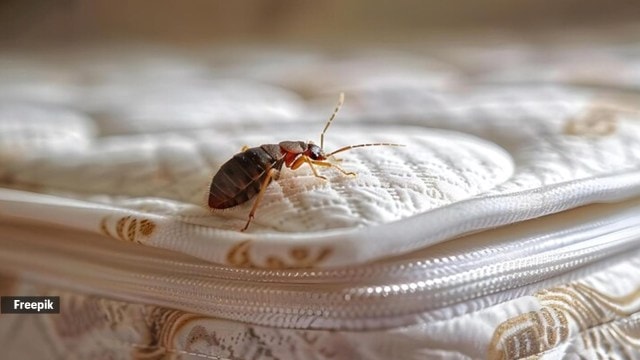📣 For more lifestyle news, click here to join our WhatsApp Channel and also follow us on Instagram
Are bed bugs attracted to certain colours?
“To find the favourite colour a research study was done on bed bugs,” said content creator Dr Sam.
 Which colours are bed bugs attracted to? (Image: Freepik)
Which colours are bed bugs attracted to? (Image: Freepik)Did you know that bed bugs might have a preference for certain colours? According to a viral post by a content creator, research suggests that bed bugs are more attracted to black and dark red, while they tend to avoid brighter colours.
In his reel, Dr Sam mentions, “To find the favourite colour a research study was done on bed bugs. They put the bug in the middle of a petri dish and gave the bug 10 minutes to cover under one of the coloured tents, and they found that most of the time bugs ended up in these two colours — black and dark red.”
He added, “They usually avoid bright colours.”
View this post on Instagram
Interestingly, according to Dr Sam, the research also found that young bed bugs didn’t show any particular colour preference, making the fight against infestations more complex than it seems.
Role of colour in attracting or repelling bed bugs
Dr Jagadish Hiremath, a public health intellectual, explains, “Research has shown that bed bugs do indeed have colour preferences, with some studies indicating that they are more attracted to darker colours, particularly red and black.”
These preferences are thought to be linked to the bugs’ instinct to seek dark, secluded areas where they can hide and avoid detection, he continues. Conversely, bed bugs seem to be less attracted to lighter colours like yellow and green, possibly because these colours mimic brighter environments that feel less secure.
However, he cautions against overemphasising colour in bed bug prevention: “While colour might play a role, it should not be the primary factor when choosing bedding. The overall cleanliness of your environment, along with factors like temperature and humidity, has a much more significant impact on bed bug infestations.”
While avoiding dark-coloured bedding might help slightly reduce the likelihood of bed bug attraction, he says, it should not replace more traditional preventative measures like regular cleaning, inspection, and pest control.
Other factors, besides colour, that influence bed bug behaviour and attraction
Dr Hiremath outlines several key factors, “Bed bugs are primarily attracted to environments that offer warmth, carbon dioxide, and a reliable food source—namely human blood. The temperature of a room plays a key role, as bed bugs thrive in warm conditions, typically around 70 to 80 degrees Fahrenheit. They are also drawn to areas where they can detect carbon dioxide emissions, which signal the presence of a host. This is why bed bugs are often found near beds, where people spend prolonged periods.”
He adds, “Other factors that influence their behaviour include clutter, which provides additional hiding places, and fabric texture, as bed bugs prefer to hide in materials like mattresses, upholstery, or curtains. Additionally, humidity levels can impact their survival, as bed bugs do better in slightly more humid environments.”
 Factors that influence their behaviour include clutter, which provides additional hiding places, and fabric texture, as bed bugs prefer to hide in materials like mattresses, upholstery, or curtains. (Source: Freepik)
Factors that influence their behaviour include clutter, which provides additional hiding places, and fabric texture, as bed bugs prefer to hide in materials like mattresses, upholstery, or curtains. (Source: Freepik)
Practical ways to incorporate colour-based strategies with traditional pest control methods for more effective bed bug prevention
While colour-based strategies alone are not a silver bullet, Dr Hiremath suggests they can complement existing methods. “Using lighter-coloured bedding and furniture combined with regular cleaning and vacuuming can make bed bugs easier to spot. Some pest control experts suggest that yellow or white bed covers may make it harder for bed bugs to hide, making infestations easier to detect early on.”
However, he emphasises that integrated pest management (IPM) strategies, which include monitoring, cleaning, heat treatments, and chemical treatments, remain the most effective means of bed bug prevention. Colour-based strategies can complement but should not replace these proven methods.
Why do young bed bugs not show the same colour preference as adult bed bugs, and how does this affect pest management strategies?
Dr Hiremath explains this intriguing difference, saying, “Young bed bugs, or nymphs, do not show the same distinct colour preferences as adult bed bugs. This could be due to their smaller size and underdeveloped sensory abilities. As a result, nymphs are less selective about their hiding spots and may be found in a wider variety of places than adults.”
Understanding this difference can influence pest management strategies by encouraging more thorough inspections, he recommends, including in lighter or more exposed areas where nymphs might hide. Since nymphs are more challenging to detect, a more comprehensive approach to cleaning and monitoring is necessary to catch infestations early on.
Dr Hiremath advises against relying solely on colour-based prevention methods. Instead, he recommends combining these strategies with traditional pest control techniques such as regular cleaning, heat treatments, and chemical control for the best protection against bed bug infestations.
📣 For more lifestyle news, click here to join our WhatsApp Channel and also follow us on Instagram





- 01
- 02
- 03
- 04
- 05






















